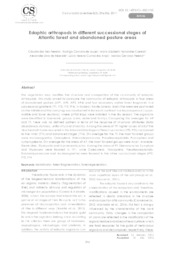Edaphic arthropods in different successional stages of Atlantic forest and abandoned.
Edaphic arthropods in different successional stages of Atlantic forest and abandoned.
Author(s): FERREIRA, C. dos R.; SOUZA, R. C. de; CORREIA, M. E. F.; RESENDE, A. S. de; ANJOS, L. H. C. dos; PEREIRA, M. G.
Summary: The vegetation may modifies the structure and composition of the community of edaphic arthropods. This study aimed to compare the community of edaphic arthropods in four areas of abandoned pasture (AP1, AP2, AP3, AP4) and four secondary native forest fragments in a successional gradient (FF1, FF2, FF3, FF4), in Itaboraí, Rio de Janeiro, Brazil. The areas are positioned on the hillside and the sampling was conducted in transects outlined in a toposequence (upper, middle and lower sections), where pitfall traps were installed in the dry season. The organisms were identified in taxonomic groups (class, order and family). Comparing the averages for AP and FF, there was no defined pattern in terms of the response of structural attributes (total abundance, richness, uniformity and diversity). Among the areas of FF, higher values of all of the structural attributes occurred in the intermediate stages of forest succession (FF2, FF3), compared to the initial (FF1) and advanced stages (FF4). On average for the FF, the most favored groups were Archaeognatha, Coleoptera, Entomobryomorpha, Pseudoscorpionida, Psocoptera and Symphypleona. On average for the areas of AP, the most favored groups were Acari, Araneae, Formicidae, Diplopoda and Auchenorrhyncha. Among the areas of FF, Sternorryncha, Symphyla and Thysanura were favored in FF1, while Coleoptera, Psocoptera, Pseudoscorpionida, Entomobryomorpha and Archaeognatha were favored in the other successional stages (FF2, FF3, FF4
Publication year: 2017
Types of publication: Journal article
Unit: Embrapa Agrobiology
Keywords: Bioindicator, Forest fragmentation, forest regeneration
Observation
Some of Embrapa's publications are published as ePub files. To read them, use or download one of the following free software options to your computer or mobile device. Android: Google Play Books; IOS: iBooks; Windows and Linux: Calibre.
Access other publications
Access the Agricultural Research Database (BDPA) to consult Embrapa's full library collection and records.
Visit Embrapa Bookstore to purchase books and other publications sold by Embrapa.

